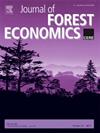从政策角度看林业部门建模的作用。
IF 0.7
4区 农林科学
Q3 ECONOMICS
引用次数: 0
摘要
本文章由计算机程序翻译,如有差异,请以英文原文为准。



Policy Perspective on the Role of Forest Sector Modeling.
求助全文
通过发布文献求助,成功后即可免费获取论文全文。
去求助
来源期刊

Journal of Forest Economics
农林科学-林学
CiteScore
1.70
自引率
0.00%
发文量
16
审稿时长
>36 weeks
期刊介绍:
The journal covers all aspects of forest economics, and publishes scientific papers in subject areas such as the following:
forest management problems: economics of silviculture, forest regulation and operational activities, managerial economics;
forest industry analysis: economics of processing, industrial organization problems, demand and supply analysis, technological change, international trade of forest products;
multiple use of forests: valuation of non-market priced goods and services, cost-benefit analysis of environment and timber production, external effects of forestry and forest industry;
forest policy analysis: market and intervention failures, regulation of forest management, ownership, taxation;
land use and economic development: deforestation and land use problem, national resource accounting, contribution to national and regional income and employment.
forestry and climate change: using forestry to mitigate climate change, economic analysis of bioenergy, adaption of forestry to climate change.
 求助内容:
求助内容: 应助结果提醒方式:
应助结果提醒方式:


